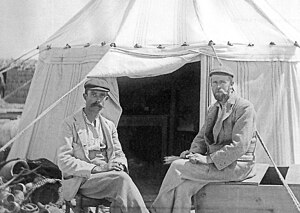
Back برديات أوكسيرينخوس Arabic Papiros d'Oxirrincu AST Papirs d'Oxirinc Catalan Papiri di Ossirincu Corsican Oxyrhynchus-Papyri German Πάπυροι της Οξυρρύγχου Greek Papiros de Oxirrinco Spanish Oxirrinkoko Papiroak Basque پاپیروس اوکسیرینخوس Persian Oksyrhynkhoksen papyrukset Finnish



The Oxyrhynchus Papyri are a group of manuscripts discovered during the late nineteenth and early twentieth centuries by papyrologists Bernard Pyne Grenfell and Arthur Surridge Hunt at an ancient rubbish dump near Oxyrhynchus in Egypt (28°32′N 30°40′E / 28.533°N 30.667°E, modern el-Bahnasa).
The manuscripts date from the time of the Ptolemaic (3rd century BC) and Roman periods of Egyptian history (from 32 BC to the Muslim conquest of Egypt in 640 AD).
Only an estimated 10% are literary in nature. Most of the papyri found seem to consist mainly of public and private documents: codes, edicts, registers, official correspondence, census-returns, tax-assessments, petitions, court-records, sales, leases, wills, bills, accounts, inventories, horoscopes, and private letters.[1]
Although most of the papyri were written in Greek, some texts written in Egyptian (Egyptian hieroglyphics, Hieratic, Demotic, mostly Coptic), Latin and Arabic were also found. Texts in Hebrew, Aramaic, Syriac and Pahlavi have so far represented only a small percentage of the total.[2]
Since 1898, academics have collated and transcribed over 5,000 documents from what were originally hundreds of boxes of papyrus fragments the size of large cornflakes. This is thought to represent only 1 to 2% of what is estimated to be at least half a million papyri still remaining to be conserved, transcribed, deciphered and catalogued. The most recent published volume was Vol. LXXXVII, released on 31 August 2023[update].
Oxyrhynchus Papyri are currently housed in institutions all over the world. A substantial number are housed in the Bodleian Art Library at Oxford University. There is an online table of contents briefly listing the type of contents of each papyrus or fragment.[3]
- ^ Professor Nickolaos Gonis from University College London, in a film from the British Arts and Humanities Research Council on Oxyrhynchus Papyri Project.
- ^ World Archaeology Issue 36, 7 July 2009
- ^ Search by table of contents; "Oxyrhynchus Online Image Database". Imaging Papyri Project. Retrieved 25 May 2007. A listing of what each fragment contains.
© MMXXIII Rich X Search. We shall prevail. All rights reserved. Rich X Search
